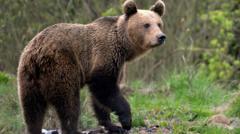The victim, identified as a male motorcyclist, had paused in a popular tourist zone when he was attacked by a bear that then dragged him nearly 80 meters down a ravine. Emergency responders confirmed he was deceased upon arrival, and the extent of his injuries was reportedly catastrophic despite the protective gear he was wearing. Local rescue service head, Ion Sanduloiu, strongly cautioned against stopping and interacting with bears, emphasizing that tourists should heed warnings against feeding wildlife.
Romania is home to the largest brown bear population in the European Union, with recent estimates suggesting between 10,400 and 12,800 bears exist in the country. This marks a significant rise from previous counts, leading experts and authorities to reconsider management strategies. Former environment minister Mircea Fechet has argued for a sustainable bear population of around 4,000, thrice lower than the current figure, and has advocated for legislative changes that would empower local authorities to act swiftly against bears encroaching on populated areas.
Investigations into the recent fatality are ongoing, with conservationists like Gabriel Paun highlighting deeper systemic issues in wildlife management rather than solely attributing them to bear overpopulation. The need for increased tourist education, proactive bear management, and the urgent implementation of national coexistence strategies is vital to mitigating future tragedies.
As human-wildlife interactions become more common, calls for stricter regulations—including steeper fines and potential jail sentences for those who feed bears— are echoed by experts hoping to provide safer environments for both residents and wildlife in Romania.
Romania is home to the largest brown bear population in the European Union, with recent estimates suggesting between 10,400 and 12,800 bears exist in the country. This marks a significant rise from previous counts, leading experts and authorities to reconsider management strategies. Former environment minister Mircea Fechet has argued for a sustainable bear population of around 4,000, thrice lower than the current figure, and has advocated for legislative changes that would empower local authorities to act swiftly against bears encroaching on populated areas.
Investigations into the recent fatality are ongoing, with conservationists like Gabriel Paun highlighting deeper systemic issues in wildlife management rather than solely attributing them to bear overpopulation. The need for increased tourist education, proactive bear management, and the urgent implementation of national coexistence strategies is vital to mitigating future tragedies.
As human-wildlife interactions become more common, calls for stricter regulations—including steeper fines and potential jail sentences for those who feed bears— are echoed by experts hoping to provide safer environments for both residents and wildlife in Romania.






















